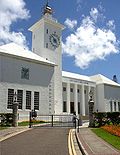British Overseas Territories
territories under the jurisdiction and sovereignty of the United Kingdom From Wikipedia, the free encyclopedia
Remove ads
Remove ads
Before 1981 they were known as Crown colonies. The British Overseas Territories are also referred to as overseas territories of the United Kingdom,[1] UK overseas territories,[2] or when the context is clear, simply the Overseas Territories.[3]There are fourteen[3] territories under the United Kingdom's sovereignty.[4]

Each of the British Overseas Territories has a government, parliament, and prime minister to amend all laws, except laws about foreign affairs and defense. The British government manages its defense and foreign affairs. British Overseas Territories which have no local population or any population, have no local self-rule. If the British Overseas Territory is ruled badly, the government of the British Overseas Territory can be taken over by the British government and ruled directly by it, without the agreement of the British Overseas Territory.
The territories of Jersey, Guernsey , and the Isle of Man, though under the sovereignty of the British Crown, have a slightly different constitutional relationship with the United Kingdom, so they are classed as Crown dependencies rather than Overseas Territories. Unlike British Overseas Territories, the British government cannot take over the government of a Crown dependency, unless the government of the Crown dependency agrees. Territories and dependencies are distinct from the Commonwealth of Nations, a voluntary association of former British colonies which are independent countries.
In a historical context, colonies should be distinguished from protectorates and protected states, which though under British control, were nominally independent states, whereas colonies were part of the British state. They should also not be confused with Dominions, which, known collectively as the Commonwealth, were independent states, held to be equal in sovereign status to the United Kingdom within the Empire and Commonwealth after the Statute of Westminster in 1931. Crown colonies, such as Hong Kong, were differentiated from other colonies in being administered directly by the Crown, without the degree of local autonomy found in self-governed colonies and other British Overseas Territories such as Bermuda.
Remove ads
Current Overseas Territories
Remove ads
Government
The head of state in the Overseas Territories is the British monarch, presently King Charles III. The King’s role in the territories is in his role as King of the United Kingdom, and not in the right of each territory. The monarch appoints a representative in each territory to exercise their executive power.
All the Overseas Territories have their system of government and localized laws. The structure of the government appears to be closely correlated to the size and political development of the territory.
Legal system
Each Overseas Territory has its legal system independent of the United Kingdom. The legal system is generally based on English common law, with some distinctions for local circumstances. Each territory has its own Attorney General, and court system. The British government may appoint a UK-based lawyer or judge to work on legal cases for the smaller territories. This is particularly important for cases involving serious crimes and where it is impossible to find a jury who will not know the Defendant in a small population island.
Remove ads
Gallery of images
- City Hall, Hamilton, Bermuda
- View of the military base at Diego Garcia, British Indian Ocean Territory
- Rock of Gibraltar
- View of Jamestown, Saint Helena
References
Related pages
Further reading
Other websites
Wikiwand - on
Seamless Wikipedia browsing. On steroids.
Remove ads




















